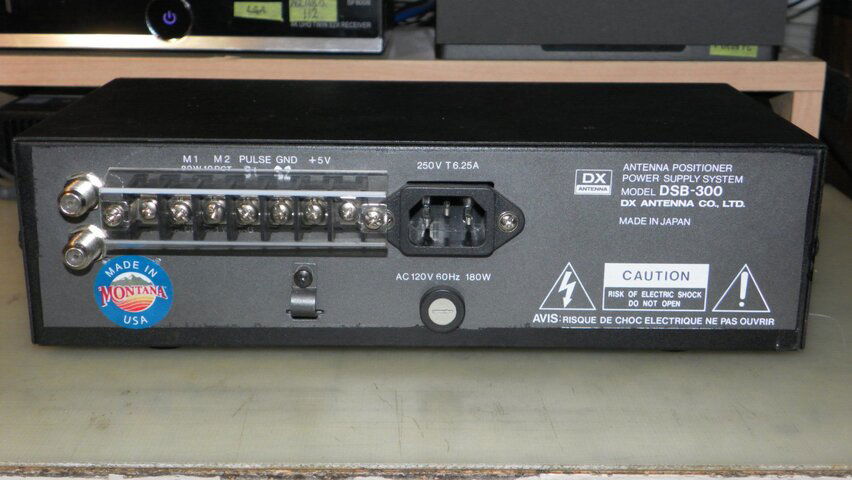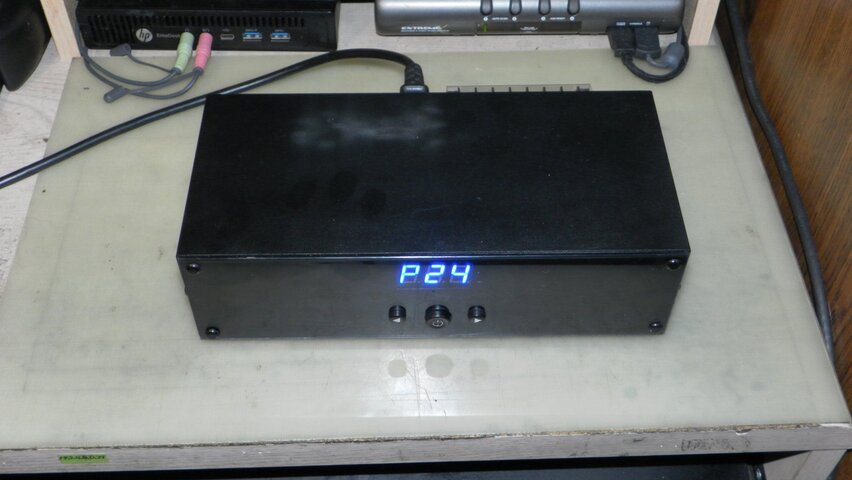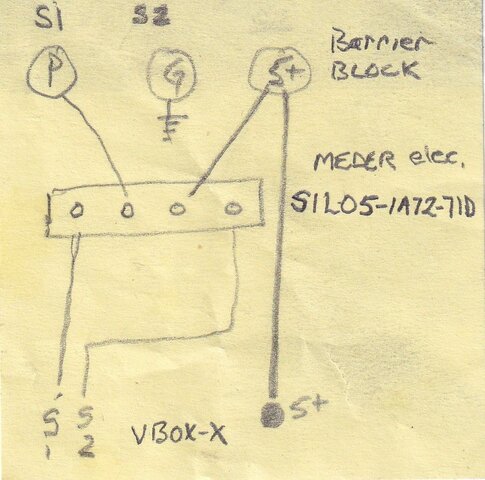I want to replace a 2-wire reed sensor with a 3-wire hall sensor in a Venture actuator. Is there a way to make this work with a Gbox? I believe that I need to get +5VDC and ground out to the hall sensor, which won't be too difficult, but can the Gbox function OK with just one sensor wire? Does anyone have a schematic for the Gbox?
replacing reed sensor with hall sensor
- Thread starter WhiteBeard
- Start date
- Latest activity Latest activity:
- Replies 52
- Views 7K
You are using an out of date browser. It may not display this or other websites correctly.
You should upgrade or use an alternative browser.
You should upgrade or use an alternative browser.
You might find information in this thread useful.

 www.satelliteguys.us
www.satelliteguys.us

New Product for ASC1 - OHR: Sensor Adapter for Optical, Hall Effect and Reed Isolation
Thanks to the talent and innovativation of SatelliteGuys member Magic Static, we are now able to offer his custom built sensor adapter for the ASC1 DiSEqC 1.2 Positioner. Introducing the Optical / Hall Effect Sensor and Reed Isolation Adapter The OHR adapter interfaces the ASC1 Satellite...
When you get super serious let me know. Mines retrofitted. Your Gbox can be done.
You need to figure out how to mount a hall sensor close to the sensor magnet. You'll need 3 wires that should be available for your reed sensor cable.
You'll need a 12VDC wall wart. 6-9 Volt will work.
A mini solid state relay. Heat shrink and some soldering skills. And several inches of hookup wire.
No moving parts in the sensor circuit, good clean Schottky triggered pulses both at the Hall sensor and at the relay.
You need to figure out how to mount a hall sensor close to the sensor magnet. You'll need 3 wires that should be available for your reed sensor cable.
You'll need a 12VDC wall wart. 6-9 Volt will work.
A mini solid state relay. Heat shrink and some soldering skills. And several inches of hookup wire.
No moving parts in the sensor circuit, good clean Schottky triggered pulses both at the Hall sensor and at the relay.
I'm repairing and installing both a Gbox and a Vbox into a different enclosure. I figure this is a good time to install a hall sensor and mod the Gbox/Vbox. So if you have a procedure to make this happen let me know. I have the hall sensor. I believe you mentioned that I'll need a separate 12 VDC source to power the hall sensor. I have some 12VDC AC adapters rated for 1A (some less than that). I don't have any 12 VDC relays but I think I can get something locally.When you get super serious let me know. Mines retrofitted. Your Gbox can be done.
You need to figure out how to mount a hall sensor close to the sensor magnet. You'll need 3 wires that should be available for your reed sensor cable.
You'll need a 12VDC wall wart. 6-9 Volt will work.
A mini solid state relay. Heat shrink and some soldering skills. And several inches of hookup wire.
No moving parts in the sensor circuit, good clean Schottky triggered pulses both at the Hall sensor and at the relay.
I just upgraded one of my VBox-X conversions to handle optical and hall effect sensors as well as reed switch type sensors. The Hall effect and optical sensors I have run across in old actuators have been the 5v type. So I used a 5v reed relay to make an adapter circuit.
Attachments
Can you post your parts list and what you did to modify your dish mover? Maybe I can adapt that to my setup.I just upgraded one of my VBox-X conversions to handle optical and hall effect sensors as well as reed switch type sensors. The Hall effect and optical sensors I have run across in old actuators have been the 5v type. So I used a 5v reed relay to make an adapter circuit.
Thanks for the info. But, Wow. Amazon wants $115 for a package of 10 while Digikey wants $50 for a package of 10. Sure pays to shop around.Just one part and a piece of circuit board to hold it. A Meder Electronic reed relay SIL05-1A72-71D I bought at Digi-Key #374-1113-ND . I drew myself a diagram real quick to keep it focused in my mind.
Last edited:
Personally, my own incantation of the adapter uses a Crydom SSR and a Schottky Hall sensor in the actuator on a chunk of PC board.
Perfect square waves with no contact glitching as shown on the good ole Tek scope
Make the Hall>magnet distance adjustable for that sweet spot to grab as best of a 50/50% waveform.
......of course not trying to confuse anyone. lol.
Perfect square waves with no contact glitching as shown on the good ole Tek scope
Make the Hall>magnet distance adjustable for that sweet spot to grab as best of a 50/50% waveform.
......of course not trying to confuse anyone. lol.
So, this is essentially just a relay? I was expecting something more elaborate. I guess that opto-isolator circuit in the Gbox isn't sufficient to filter out noise on the line?
Just another shocker you would never hear at a car dealership. 'Well, maybe you should go buy a Honda".So, this is essentially just a relay? I was expecting something more elaborate. I guess that opto-isolator circuit in the Gbox isn't sufficient to filter out noise on the line?
That's basically what I got from the supposed lead of the Zito sales team. After days and weeks of describing my issues with my cable service. Complete with screen shots of wavering signal and massively incrementing Uncorrectable/Corrected stats which were supposed to be forwarded to the engineering dept. The engineering department is totally unreachable directly by phone, and the building commonly called the Taj Mahal is locked down tight as a bulls you-know-what at fly time where a common person cannot enter.
The lead field engineer (not just a F connector splicer) was fired some time ago because Zito forced him back into full time duty after an auto accident where doctors orders said partial light duty.
Tons of people here were livid at failed VOIP, DVR, and Internet failures. Tech support and field tech's did not fix their problems.
One text message to Isaac of my modem stats and he headed to the front end and swapped out a glitchy CMTS and a few line amps. Problems solved, and customers settled down all over. For the longest time.
So, back to the first part. I called the sales lead and talked with him of how he could sell a defective product, how word of mouth and lax service repairs plagued his company. And how going to the competitor just looked too good considering it was a only little more a month. And how it's pretty sad when customers who are so fed up were getting satellite Internet installed. How people having their VOIP service were taking my advice and going to Vonage.
His respones? "Well maybe then you had better go to Tri County Connections".
That was sweet. I wonder if his call was being monitored for quality assurance.
You won't get noise, with shielded wire, and grounded, try grounding at the dish end only. All sat ribbon cable is that way I never had a noise issue using a reed switch, von wise made a special double magnet wheel for KU, I might have some laying around hall switches die too easy when lighting is around, same with optical sensors.So, this is essentially just a relay? I was expecting something more elaborate. I guess that opto-isolator circuit in the Gbox isn't sufficient to filter out noise on the line?
The only issue I have seen from what your thinking is noise, is a bad house-ground or the AC power outlet to your receiver is plugged into is an outlet with neutral and ground, wrong bad house grounds will cause issues when the dish moves and your furnace or well pump or anything that draws a lot of current, is turned on while the dish is moving, you get a ground loop, in your reed switch circuit and the dish gets off position, the house power tries to use the dish ground.
Fix your house ground, I saw it happen at least 3 times doing C-band, in all cases, I was perhaps the 3rd or 4th guy called in the others were not electronic people
Last edited:
Huh?Just another shocker you would never hear at a car dealership. 'Well, maybe you should go buy a Honda".
That's basically what I got from the supposed lead of the Zito sales team. After days and weeks of describing my issues with my cable service. Complete with screen shots of wavering signal and massively incrementing Uncorrectable/Corrected stats which were supposed to be forwarded to the engineering dept. The engineering department is totally unreachable directly by phone, and the building commonly called the Taj Mahal is locked down tight as a bulls you-know-what at fly time where a common person cannot enter.
The lead field engineer (not just a F connector splicer) was fired some time ago because Zito forced him back into full time duty after an auto accident where doctors orders said partial light duty.
Tons of people here were livid at failed VOIP, DVR, and Internet failures. Tech support and field tech's did not fix their problems.
One text message to Isaac of my modem stats and he headed to the front end and swapped out a glitchy CMTS and a few line amps. Problems solved, and customers settled down all over. For the longest time.
So, back to the first part. I called the sales lead and talked with him of how he could sell a defective product, how word of mouth and lax service repairs plagued his company. And how going to the competitor just looked too good considering it was a only little more a month. And how it's pretty sad when customers who are so fed up were getting satellite Internet installed. How people having their VOIP service were taking my advice and going to Vonage.
His respones? "Well maybe then you had better go to Tri County Connections".
That was sweet. I wonder if his call was being monitored for quality assurance.
oh crap. was for another post. my internet is jumpy as heck today.Huh?
Admins. Delete please.
My house grounding must be OK (?) since I don't have issues with my ham equipment getting into any of the other electronics in the house and vice versa. It looks like I have single point grounding but I did notice that the service entrance ground rod wasn't the standard 5/8" and it probably isn't the standard 8 foot long ground rod either. The previous owner put concrete around it, also, so it'll be a challenge to replace it. The ground wire certainly isn't exothermic welded to the rod. And the original installation connected the breaker box ground to the copper water pipe via a saddle clamp. My plumber said that I should have that changed because it'll eventually corrode through the pipe. It's all copper pipe here except for the water line to the laundry faucets (I think it's called PEX tubing?). The dishes are grounded to a ground rod right next to them and they are tied into the service entrance ground. My towers are tied to the same point. I have the ribbon shield tied to the grounding at the Gbox/Vbox end. If I have to, I'll hire an electrician to look things over. As far as I know, the house electrical wiring hasn't been altered since the city inspected the wiring back in 1985 when the house was built. I did check some house grounds a few years ago and didn't find any ground/neutral or neutral/hot reversals.You won't get noise, with shielded wire, and grounded, try grounding at the dish end only. All sat ribbon cable is that way I never had a noise issue using a reed switch, von wise made a special double magnet wheel for KU, I might have some laying around hall switches die too easy when lighting is around, same with optical sensors.
The only issue I have seen from what your thinking is noise, is a bad house-ground or the AC power outlet to your receiver is plugged into is an outlet with neutral and ground, wrong bad house grounds will cause issues when the dish moves and your furnace or well pump or anything that draws a lot of current, is turned on while the dish is moving, you get a ground loop, in your reed switch circuit and the dish gets off position, the house power tries to use the dish ground.
Fix your house ground, I saw it happen at least 3 times doing C-band, in all cases, I was perhaps the 3rd or 4th guy called in the others were not electronic people
He put concrete around the ground rod? How much concrete? Try throwing a couple pails of plain water on it, with the intention of getting the ground around it soaked as much as possible.
IF you can do that, see if it makes any difference with your "noise" issue. IF it does, it's definitely an inadequate grounding issue. You MIGHT be able to fix it by pounding in a standard grounding rod as close as you can get to the cemented-in one, and bonding them together.
IF you can do that, see if it makes any difference with your "noise" issue. IF it does, it's definitely an inadequate grounding issue. You MIGHT be able to fix it by pounding in a standard grounding rod as close as you can get to the cemented-in one, and bonding them together.
It's a concrete pad for a patio. I'm not sure how thick it is. But I doubt that any water can get down around the rod. I wouldn't be able to get another ground rod near the existing one without chopping up the concrete.He put concrete around the ground rod? How much concrete? Try throwing a couple pails of plain water on it, with the intention of getting the ground around it soaked as much as possible.
IF you can do that, see if it makes any difference with your "noise" issue. IF it does, it's definitely an inadequate grounding issue. You MIGHT be able to fix it by pounding in a standard grounding rod as close as you can get to the cemented-in one, and bonding them together.
Concrete patio pads aren't that thick. He probably pounded the ground rod way in, then poured the patio around it. My guess is the ground under the patio has dried out, and lost conductivity. Your "ground" isn't a ground any more, and needs to be replaced. This is something you'll need an electrician for, at the very least for building code compliance as well as safety. Your actual ground may be the dishes' rod, connected to your service entrance ground. Yikes! 

As a coincidence I recently replaced my house ground rod and it went through a slab but there was a little clearance around the rod like they drilled the slab and put the rod in after. I have a meter that measures ground rod resistance and my 50 yr old ground rod was around 15 ohms where the goal is 5 ohms or less.
If the rod is stuck in a concrete slab it will probably not be more than 4" thick and you might be able to break up the concrete around the rod using small concrete chisels then core a nice looking hole through the concrete after the rod is out.
Residential rods are usually 8ft long 5/8in diameter and I would replace with a 10ft long 3/4in dia. That will go deeper and take a new bite in the soil making good contact. To pull the old rod out I used vice grips on the exposed rod attached to a chain and pulled it up with an off roaders "sheepherders jack" It came out very easy this way. To put the new rod in rent a jack hammer with ground rod attachment and it will go in faster than the time it took to sign the papers at the rental yard. A consumer size hammer drill may work with the proper attachment and I did that using about 70lbs of extra weight on my little hammer drill. It took about 10 minutes to pound in and trying to do that with a sledge hammer would have been a nightmare. My new ground rod resistance came in around 4.6 ohms and all is good.
I've seen noise induced onto actuator arm turn sensing lines from people using an arc welder and other high current tools near by and the wires back to the controller in this case were not shielded. Pulling new shielded wire was not possible so I terminated the wires at the controller with resistors and the values were chosen to give good reliable count pulse voltage at the controller but low enough in resistance to snuff out extraneous voltages picked up on the unshielded lines. That worked great and no more false counts from noise taking our controllers off satellites.
I can't imagine anyone getting interference to the actuator arm turn sensing wires using shielded cable but in rare cases the ground at the dish is a vastly different potential than where the indoor equipment is and you can have AC current on the shield wires as they try to equalize the ground potential. In some cases this can induce a little voltage on the wires inside the shield and you can see that with an oscilloscope. The fix for that is simple, disconnect the shield at the dish. You will still have an electrostatic shield on the wires but it wont try to equalize ground potential any longer or have ground currents. Noise problem maybe solved.
If the rod is stuck in a concrete slab it will probably not be more than 4" thick and you might be able to break up the concrete around the rod using small concrete chisels then core a nice looking hole through the concrete after the rod is out.
Residential rods are usually 8ft long 5/8in diameter and I would replace with a 10ft long 3/4in dia. That will go deeper and take a new bite in the soil making good contact. To pull the old rod out I used vice grips on the exposed rod attached to a chain and pulled it up with an off roaders "sheepherders jack" It came out very easy this way. To put the new rod in rent a jack hammer with ground rod attachment and it will go in faster than the time it took to sign the papers at the rental yard. A consumer size hammer drill may work with the proper attachment and I did that using about 70lbs of extra weight on my little hammer drill. It took about 10 minutes to pound in and trying to do that with a sledge hammer would have been a nightmare. My new ground rod resistance came in around 4.6 ohms and all is good.
I've seen noise induced onto actuator arm turn sensing lines from people using an arc welder and other high current tools near by and the wires back to the controller in this case were not shielded. Pulling new shielded wire was not possible so I terminated the wires at the controller with resistors and the values were chosen to give good reliable count pulse voltage at the controller but low enough in resistance to snuff out extraneous voltages picked up on the unshielded lines. That worked great and no more false counts from noise taking our controllers off satellites.
I can't imagine anyone getting interference to the actuator arm turn sensing wires using shielded cable but in rare cases the ground at the dish is a vastly different potential than where the indoor equipment is and you can have AC current on the shield wires as they try to equalize the ground potential. In some cases this can induce a little voltage on the wires inside the shield and you can see that with an oscilloscope. The fix for that is simple, disconnect the shield at the dish. You will still have an electrostatic shield on the wires but it wont try to equalize ground potential any longer or have ground currents. Noise problem maybe solved.
Good point. I should've corrected this years ago. I had noticed this issue when I bought the house but I figured if it was good enough for the city. When I had the air conditioning replaced they didn't say anything about the ground rod then either. I suppose I should hire an electrician to fix the issue even though it's not that difficult of a task. I installed ground rings around microwave radio sites and towers at one time. I'd like to put a ground ring around the house but that would cost a bit of money. It all comes down to money.......Concrete patio pads aren't that thick. He probably pounded the ground rod way in, then poured the patio around it. My guess is the ground under the patio has dried out, and lost conductivity. Your "ground" isn't a ground any more, and needs to be replaced. This is something you'll need an electrician for, at the very least for building code compliance as well as safety. Your actual ground may be the dishes' rod, connected to your service entrance ground. Yikes!
Similar threads
- Replies
- 9
- Views
- 2K
- Replies
- 3
- Views
- 1K
- Replies
- 10
- Views
- 2K
- Replies
- 8
- Views
- 716





